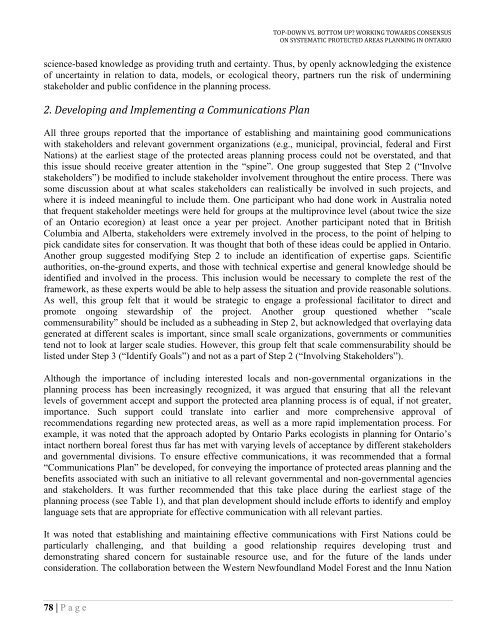Top-Down vs. Bottom Up: Working Towards Consensus ... - CASIOPA
Top-Down vs. Bottom Up: Working Towards Consensus ... - CASIOPA
Top-Down vs. Bottom Up: Working Towards Consensus ... - CASIOPA
- No tags were found...
Create successful ePaper yourself
Turn your PDF publications into a flip-book with our unique Google optimized e-Paper software.
TOP-DOWN VS. BOTTOM UP? WORKING TOWARDS CONSENSUSON SYSTEMATIC PROTECTED AREAS PLANNING IN ONTARIOscience-based knowledge as providing truth and certainty. Thus, by openly acknowledging the existenceof uncertainty in relation to data, models, or ecological theory, partners run the risk of underminingstakeholder and public confidence in the planning process.2. Developing and Implementing a Communications PlanAll three groups reported that the importance of establishing and maintaining good communicationswith stakeholders and relevant government organizations (e.g., municipal, provincial, federal and FirstNations) at the earliest stage of the protected areas planning process could not be overstated, and thatthis issue should receive greater attention in the “spine”. One group suggested that Step 2 (“Involvestakeholders”) be modified to include stakeholder involvement throughout the entire process. There wassome discussion about at what scales stakeholders can realistically be involved in such projects, andwhere it is indeed meaningful to include them. One participant who had done work in Australia notedthat frequent stakeholder meetings were held for groups at the multiprovince level (about twice the sizeof an Ontario ecoregion) at least once a year per project. Another participant noted that in BritishColumbia and Alberta, stakeholders were extremely involved in the process, to the point of helping topick candidate sites for conservation. It was thought that both of these ideas could be applied in Ontario.Another group suggested modifying Step 2 to include an identification of expertise gaps. Scientificauthorities, on-the-ground experts, and those with technical expertise and general knowledge should beidentified and involved in the process. This inclusion would be necessary to complete the rest of theframework, as these experts would be able to help assess the situation and provide reasonable solutions.As well, this group felt that it would be strategic to engage a professional facilitator to direct andpromote ongoing stewardship of the project. Another group questioned whether “scalecommensurability” should be included as a subheading in Step 2, but acknowledged that overlaying datagenerated at different scales is important, since small scale organizations, governments or communitiestend not to look at larger scale studies. However, this group felt that scale commensurability should belisted under Step 3 (“Identify Goals”) and not as a part of Step 2 (“Involving Stakeholders”).Although the importance of including interested locals and non-governmental organizations in theplanning process has been increasingly recognized, it was argued that ensuring that all the relevantlevels of government accept and support the protected area planning process is of equal, if not greater,importance. Such support could translate into earlier and more comprehensive approval ofrecommendations regarding new protected areas, as well as a more rapid implementation process. Forexample, it was noted that the approach adopted by Ontario Parks ecologists in planning for Ontario‟sintact northern boreal forest thus far has met with varying levels of acceptance by different stakeholdersand governmental divisions. To ensure effective communications, it was recommended that a formal“Communications Plan” be developed, for conveying the importance of protected areas planning and thebenefits associated with such an initiative to all relevant governmental and non-governmental agenciesand stakeholders. It was further recommended that this take place during the earliest stage of theplanning process (see Table 1), and that plan development should include efforts to identify and employlanguage sets that are appropriate for effective communication with all relevant parties.It was noted that establishing and maintaining effective communications with First Nations could beparticularly challenging, and that building a good relationship requires developing trust anddemonstrating shared concern for sustainable resource use, and for the future of the lands underconsideration. The collaboration between the Western Newfoundland Model Forest and the Innu Nation78 | P a g e


